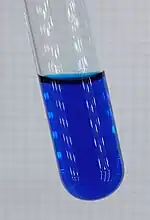| Identifiers | |
|---|---|
3D model (JSmol) |
|
PubChem CID |
|
| |
| |
| Properties | |
| Co(OCN)2 | |
| Molar mass | 142.97 g/mol |
| Related compounds | |
Other anions |
Cobalt(II) thiocyanate |
Except where otherwise noted, data are given for materials in their standard state (at 25 °C [77 °F], 100 kPa).
Infobox references | |
Cobalt(II) cyanate is the hypothetical inorganic compound with the formula Co(OCN)2.
The simple cobalt(II) cyanate has not been proven to be made. However, the tetraisocyanatocobalt(II) ion (Co(NCO)42-) is known and its blue color and is used as a qualitative test for cobalt(II) ions.
History
Cobalt(II) cyanate was claimed to have been produced in 1952 by carefully heating pyridine cobalt(II) cyanate under vacuum. This has not been proven.[1]
In contrast, the tetraisocyanatocobalt(II) ion (Co(NCO)42-) has been identified by X-ray crystallography and is widely known.[2] After being first produced in 1871, it has been used as a qualitative test for cobalt(II).[3]
Other cyanate complexes of cobalt have been discovered, such as tetrakis(pyridine)cobalt(II) cyanate.[4]
Complexes
Tetracyanatocobaltate(II)

Multiple compounds of the related tetracyanatocobaltate(II) has been structurally elucidated, such as [Co(C5H5)2]2[Co(NCO)4]. All of these complexes have an intense blue color.[2][5]
Potassium tetraisocyanatocobaltate(II) has been produced by the reaction of potassium cyanate and cobalt(II) nitrate:[6]
- 4 KOCN + Co(NO3)2 → K2[Co(NCO)4] + 2 KNO3
Tetracyanatocobaltate(II) salts with other counterions, such as cobaltcenium [Co(C5H5)]+ and EMIM are known.[2]
Other adducts
Cobalt(II) cyanate complexes have been produced by the addition of potassium cyanate to a soluble cobalt salt, such as cobalt(II) chloride, followed by the addition of the complexing agent, such as pyridine, bipyridine,[7] quinoline, and 2,6-dimethylpyrazine.[8]
Structure
Although the simple cyanate is unknown, the structure of the tetracyanatocobaltate(II) ion has been elucidated. The [Co(NCO)4]2- ion consists of a nitrogen-bonded tetrahederal central cobalt atom. The cobalt-nitrogen bond length is about 1.96 Å.[2]
References
- ↑ Albert V. Logan; David C. Bush; Charles J. Rogers (1952). "The Heats of Formation of Cobalt(II) and Nickel(II) Pyridinated Cyanates and Thiocyanates". Journal of the American Chemical Society. 74 (16): 4194–4195. doi:10.1021/ja01136a069.
- 1 2 3 4 Tim Peppel; Alexander Hinz; Philipp Thiele; Monika Geppert-Rybczyńska; Jochen K. Lehmann; Martin Köckerling (2017). "Synthesis, Properties, and Structures of Low-Melting Tetraisocyanatocobaltate(II)-Based Ionic Liquids". European Journal of Inorganic Chemistry (5): 885–893. doi:10.1002/ejic.201601250.
- ↑ C. W. Blomstrand (1871). "Zur Kenntniss der gepaarten Verbindungen des fünfatomigen Stickstoffs" [Towards the knowledge of the paired compounds of five-atom nitrogen]. Journal für Praktische Chemie (in German). 3 (1): 186–224. doi:10.1002/prac.18710030119.
- ↑ A.H. Norbury (1975). "Coordination Chemistry of the Cyanate, Thiocyanate, and Selenocyanate Ions". Advances in Inorganic Chemistry and Radiochemistry. 17: 231–386. doi:10.1016/S0065-2792(08)60064-3.
- ↑ Karin Ruhlandt-Senge; Irina Sens; Ulrich Müller (1991). "Die Bildung von [Co(C5H5)2]NO3 und [Co(C5H5)2]2[Co(NCO)4] aus Cobaltocen, Ozon und Acetonitril sowie deren Kristallstrukturen" [Formation of [Co(C5H5)2]NO3 and [Co(C5H5)2]2[Co(NCO)4] from Cobaltocene, Ozone and Acetonitrile and their Crystal Structures]. Zeitschrift für Naturforschung B (in German). 46 (12): 1689–1693. doi:10.1515/znb-1991-1218.
- ↑ F. Albert Cotton; Margaret Goodgame (1961). "Magnetic Investigations of Spin-free Cobaltous Complexes. V. Tetra-azido and Tetracyanato Cobaltate(II) Ions". Journal of the American Chemical Society. 83 (8): 1777–1780. doi:10.1021/ja01469a001.
- ↑ LI Jia; Ling-Qian Kong; Da-Cheng Li (2008). "cis-Bis-(2,2'-bipyrid-yl)dicyanato-cobalt(II)". Acta Crystallographica Section E. 64 (4): 582. doi:10.1107/S1600536808007617. PMC 2960999.
- ↑ A. B. P. Lever; S. M. Nelson (1966). "An analysis of the electronic spectra of bis-amine cobalt halides: a novel effect of steric hindrance". Journal of the Chemical Society A: Inorganic, Physical, Theoretical: 859–863. doi:10.1039/J19660000859.